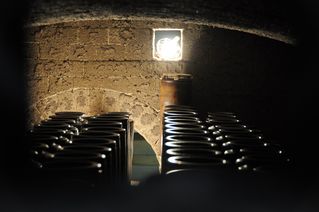Japanese pottery (Bizen porcelain ware) EE/h2>
Firm porcelain fired by high temperature were becoming among common people, but Bizen created firmer and durable mortars that people said ânever cracked even if you throw away.âEBottles and jars also had a good fame of its firmness which was one of the advantages of Bizen. Therefore, they mainly made mortars, bottles, and jars. Bottles were used for water or alcohol storage, and jars were used for grain, water, or money storage. It is thought that these 3 utensils were enough to meet public demands. Bizen porcelain ware gradually became popular. For common people, firmness was the most valuable point therefore Bizen must have been the trustworthy top brand.

Making cup
Letâs just look back and think about how pottery artists felt during the shifting period from Sue ware to Bizen porcelain ware.Sue ware production was popular and stable. The population had them need to produce more ware, and to make their kiln bigger. The amount of the material for wood-firing, red pines were getting less. They ordinarily cut trees nearby at the flat field âEbut saw many red pines grow wild at close mountains. Hiking to cut trees and bring them back down here was tough âEthey soon found that it was not a realistic work. They became to hate the cutting work. You could imagine that their mind naturally shifted to live in a mountain. Some may have suggested building a kiln at mountain and making a commune around there.
Itâs still under the research why and how Bizen freed itself from Sue ware production, but it could be the reason âEa change of residence place. Although kilns arose resolution (to fire with less air) on a field, it changed to arise oxidization (to fire with a lot of air) on sharp angle tending to raise high temperature in a mountain. Bizen porcelain wareâs characteristic such as reddish brown color might have been originated such a mountain circumstance.
Letâs get back to the story. As the top brand of mortars, bottles, and jars, Bizen took off to build a huge kiln in the 16th century. It was widely in circulation with more product line-ups more than Western Japan. The production expansion was indispensable since Bizen flower vase was considered as very valuable for a tea ceremony which was in fashion at the time. However, it was unable to build a large scale of kiln in a mountain, and inconvenient for a distribution. Pottery artists decided to come back to the flat field for the geographical circumstances and convenience. They built three huge kilns, and its management and sales were authorized to the following six families, Kimura, Mori, Tonomiya, Terami,Ooae, and Kaneshige. By this, others were forbidden to newly participate kiln building and sales activities. New young pottery artists had to belong to one of the three kiln groups.

In the kiln
The three kilns were huge; the each length had 30m to 50m like a long tunnel. Bizen artists created huge jars which were over1 meter height each one after another for an annual firing day, and over 30,000 pieces occupied in a kiln. The firing kept over 1 month; it must have been a huge event beyond your imagination âEthey used tremendous woods of 60 tons. The last half of firing, they kept putting woods to the fire. It must have been a murderous fight with heat like burning out the field all. You cannot easily picture yourself how far the fire went up from the kilns. These three kilns had kept producing representative masterpieces by the time when its system was broken in the middle of 19th century.
Bizen porcelain ware declined in the power by an influence of other porcelain ware which was popular in the 18th century. It is thought to be the end of big kilnâs period, and each family started to build a smaller kiln. The government power was unstable, and such situation got Bizen stuck. Bizen people continuously kept working on, and repeating a lot of trials and errors for the purpose to be alive, to last masterpieces, and longing for their possibilities with the clay. They kept asking the time when Bizen finally raised again in the 20th century.
In the 20th century, Bizen explosively got a smash hit, and 561 Bizen artists had been recorded during its peak. Bizen porcelain ware can be said to be influenced by a trend of the times since it is always for common people. When they were in power they produced porcelain ware a lot, but when not, they anyhow tried to get by with their great patience. Now Bizen is, as you see the ascended smoke and fire from chimneys, carrying out their way, and piecing their independent style.
